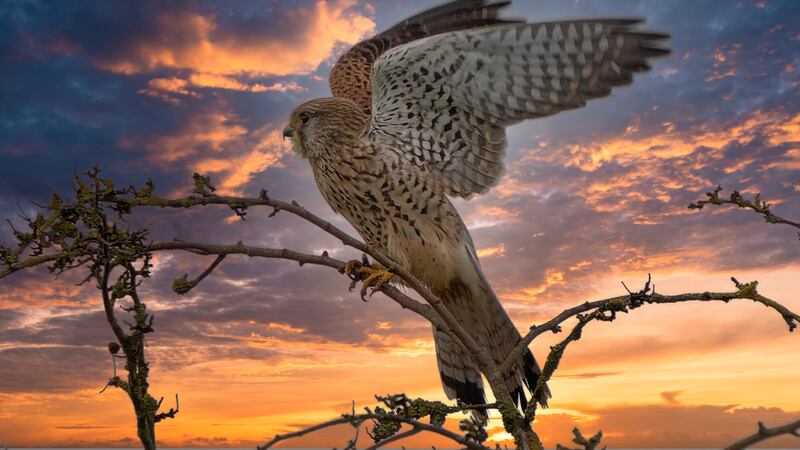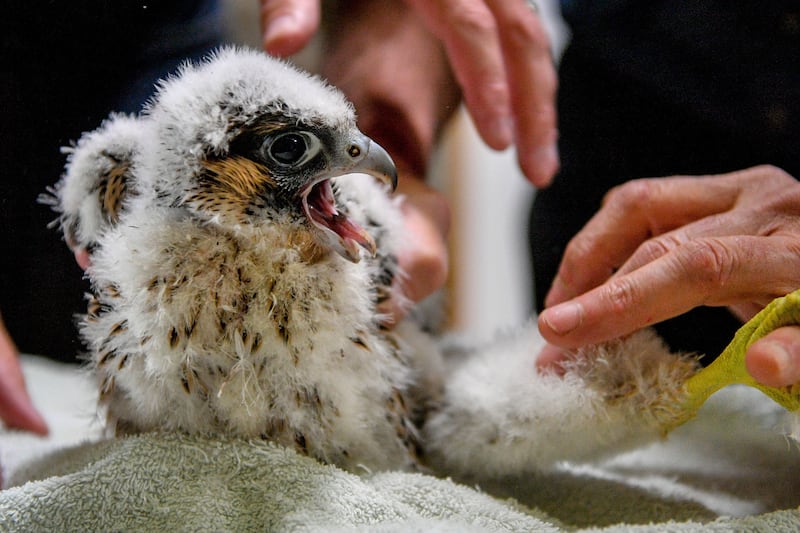Birds of prey or raptors, as they are known, are thrilling birds, characterised by their intensely focused eyes, sharp talons, hooked beaks and mastery of flight.
Their appearance and presence send a chill through smaller birds and animals upon which they prey.
Often the frantic and sudden dispersal of waders on a coastal mudflat or small birds near a bird table, is a sign a hunting raptor is close.
They also, however, exhibit an elegance and grace, especially during their aerial displays involving, rolls, tumbles, elaborate dance and talon locking. As top predators they have been in frequent conflict with man through the centuries, often persecuted to extinction in many countries including Ireland.
Because of their majestic appearance, flying abilities and spectacular hunting skills, raptors are associated with much symbolism and imagery across the world.
In the Book of Job from the Bible’s Old Testament, God questions Job about many wild animals including birds of prey asking, “Doth the hawk fly by thy wisdom, and stretch her wings toward the south? Doth the eagle mount up at thy command, and make her nest on high? She dwelleth and abideth on the rock, upon the crag of the rock, and the strong place. From thence she seeketh the prey, and her eyes behold afar off.” (Job 39:26-29).
I had the joy of encountering a pair of peregrine falcons in their breeding territory recently, watching the male scanning for danger from a cliff-top before joining the female for some aerial acrobatics, using their broad pointed wings to dive and manoeuvre together.
I first met this stocky falcon years ago, at the large limestone cliff known as the Hanging Rock, overlooking Lower Lough MacNean, close to Florencecourt, Co Fermanagh. I’ve seen the bird on several occasions since both inland and at the coast, but this was my first time to observe and fully appreciate the peregrine’s detailed markings and witness its powerful mastery of the sky.
The larger female and male both share the blue-grey upperparts, black bars across the white chest and belly, white throat, and black moustache markings. Its name Falco peregrinus, references the bird’s sharp claws from the Latin ‘falcis’ meaning a ‘sickle’ while peregrinus means ‘wanderer’ or ‘pilgrim’ noting the peregrine’s ability to travel distances.
The ancient practice of falconry goes back some 3,000 years when falcons were used by kings and princes to hunt smaller birds and game.
One story tells that the French king during 1589-1610, Henry IV, had a peregrine with a name tag which escaped, to be found 12 days later 1,300 miles away in Malta. Considered the fastest animal on the planet, the peregrine falcon reaches speeds of over 200 miles per hour when executing its dive or ‘stoop’ for prey, such as pigeons and songbirds.
The bird starts from a great height, folds its wings back and drops into a nosedive until it strikes its prey with both feet, often killing it on impact.
Fabhcún gorm, the blue falcon, nests high on cliffs, choosing a ledge where two to five eggs are laid in a simple scrape. They also inhabit our towns and cities, nesting on the ledges of church buildings and skyscrapers, perfect for scoping all around. The bird is widespread throughout Ireland, having recovered from a dramatic decline in the 1950s and 60s due to poisoning from pesticides.
On my most recent visit to the nesting area, the female rose from her clutch of eggs to chastise a raven which ventured too close, a timely reminder for me to also keep my distance.





